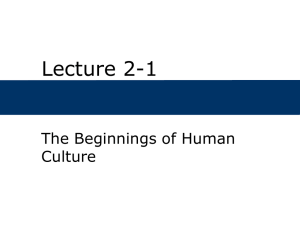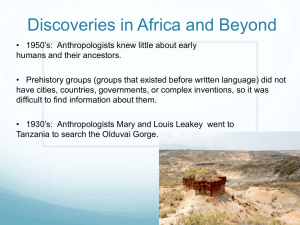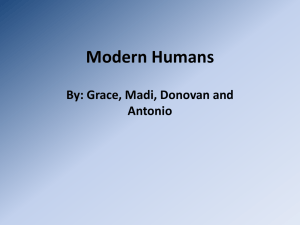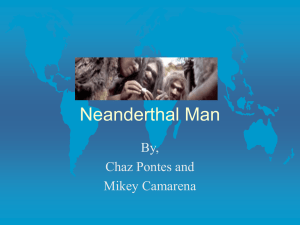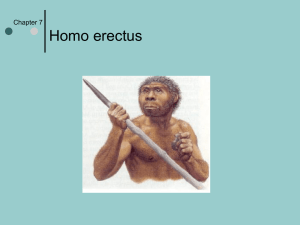The Paleolithic Age
advertisement
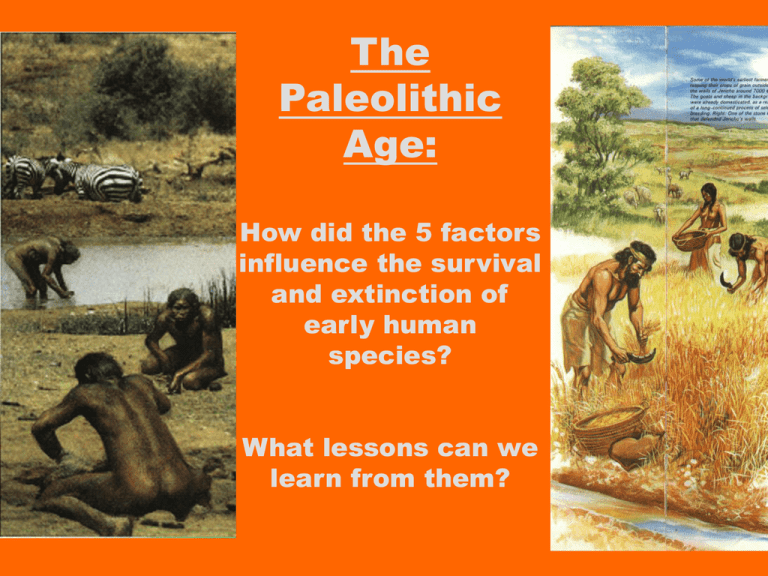
The Paleolithic Age: How did the 5 factors influence the survival and extinction of early human species? What lessons can we learn from them? The Who, What, Where, When: Prehistoric Time before written record. Roughly 99% of human time. Consists of two periods. Paleolithic “Old Stone Age” when tools were made by chipping and flaking. Neolithic Neolithic: “Neolithic Age” when tools were made by grinding stone. Hominids: Members of the Human Species both current humans and extinct. Rapidly changing science. Australopithecus Earliest identified human ~4 million y.a. to 1 m.y.a. Lived in Africa Homo Habilis “Man with Ability” 2m.y.a.-1m.y.a.; lived in Africa Homo Erectus “Man who walks upright” 1m.y.a – 200,000 y.a. Lived in Africa, southern Europe and Asia Homo Sapien Neanderthalis 100,000y.a to ?, lived in Europe and Asia Homo Sapien Sapien (Cro Magnon) (Modern Man) “Man who thinks” ~70,000y.a. to present. Spread across globe Cro Magnon: Name of modern man before Neolithic Rev. Named after town in France where first remains were found. Lesson One: Use of Resources and Tools in the rise of the Paleolithic. The Question: Why do Humans create tools and other material goods? How many do we really need? Lesson One: Humans developed technologies (tools) to help them meet their needs for survival The top 5 needs for Survival Humans, they’re what’s for dinner. Humans could however make tools to help them. Humans developed physical traits and tools to help them get food, shelter and to reproduce. Humans have no natural tools or weapons. Therefore, they were at the bottom of the food chain. But, unlike other animals they had a complex brain and opposable thumbs. With these two things they could make technologies (tools) to help them survive. See next slides. Physical Traits: Could stand on two legs Frees up hands, can look around, Small size, doesn’t need a lot to eat, but makes them vulnerable. Food Tools: Termite Stick and femur bone clubs. Shelter: None Repo: None Australopithecus Homo Habilis Physical Traits: Larger brain = more complex tools Larger Body – more rugged but means need more food. Still needs all four limbs to walk. Food Tools: Oldavai Pebble Tool. Still just a scavenger Shelter Tools: None, lived in trees most likely. Repo: Nope. Physical Traits: More Muscle and Bone Mass- Extremely Tough, but even more food needed. Larger brain= Even More Sophisticated Tools First to walk on two legs all the time: Allows them to migrate to new places. Allows them to carry more stuff. First Hunters with a Diverse tool kit: Food Tools: Achulean Hand Axe Wooden Spears and clubs Use Fire Shelter: First to begin living in caves. First to possibly wear clothing. Homo Erectus Physical Traits: Largest Body yet Bone almost twice our size. But means needs a lot of protein. Larger Brain: Even more sophisticated Tools. New Evidence Suggests were capable of speech. But is it language? Food Technology: •Use and Keep Fire as a tool •Fire Hardened Spears Neanderthal •Stone tools for processing food •Rough baskets for collecting food Shelter Technology: •Cave Dwellers •Skin and hide clothing •Repo: No Evidence Physical traits: Not as much muscle mass: required less food. Largest Brain: Very sophisticated tools Food Technologies: •Can Make own Fire •Atlatl, slings, snares •Pottery for storing food Shelter Technologies: Cro Magnon (Modern Human) •Burin •Awls and Needles •Clothing and Tents Reproduction Technologies •Decorative Items •Status Symbols •Earth Mother Statues Atlatl HOME BURIN AND NEEDLE Connections: Task One: You have 5 minutes to list everything you personally own. Swap lists with a partner. Categorize each item that is used for survival: A=air; WWater; F=Food; R=Attraction Device; S=Shelter. Task Three: From your list of items you own: How many items on your list that are not related to survival? What is their purpose? When in history do you think people began creating these types of technologies? What is the implication for our world that we have so many more possessions? Lesson One: Big Ideas Check Historical Literacy Terms: Add to your list in packet. Atlatl Rise and Fall Concepts What are the 5 things humans need to survive? Identify one most important technology for each of the 5 species What is the connection between brain size and tool sophistication? Lesson Two: Human Culture (Behaviors, Beliefs, Arts) reshaped the environment. The Question: How did the practices of the early humans reshape the environment they lived in to help them survive. Warm Up: Think back to Quest For Fire. Make a list of the ways that you saw the Neanderthals changing their environment. Then make a list of the ways you remember the Cro Magnons changing their environment. Early Human Culture reshaped the environment to help them survive: Australospithicus and Homo Habilis, Homo Erectus, Neanderthal, Cro Magnon They couldn’t and it wasn’t. They had very little to no impact on changing their environment. They had to deal with what they were given or die. Temporary impact on environment. Hunting might burn grassland. Might modify a hole in the ground and call it home. Could build shelters and make clothes to make the environment more suitable Begin to tame wild animals and change their nature. Lesson Two: Big Ideas Check Historical Literacy Terms: Add to your list in packet. Rise and Fall Concepts Which human species had the biggest ability to change their physical environment? Historical Connections: Complete the following statement: Cultures that can change their environment will…. Lesson Three: The environment reshapes the culture. The Question: How did the environment of the early humans shape their cultures. Warm Up: What are the 4 aspects of culture? Can you give an example of each for Neanderthal and Cro Magnon for each aspect from Quest for Fire. L3: The environment was responsible for the development of early human cultures. Australospithicus and Homo Habilis, Homo Erectus, Neanderthal and Cro Magnon Culture was just about survival. Behaviors: Food and Repro Art: Tools for hunting Beliefs: ? Institutions: Family Tribes Start to develop more sophisticated cultures: Language Behavior: Neanderthals can communicate, but not language Cro Magnons develop first actual languages. L3: The environment was responsible for the development of early human cultures. Hunter Gatherer Institutions Men hunt (sometimes successfully), while women gather. Women actually keeping clan alive. Gender roles were probably equal. Nomadic Behaviors Neanderthal and Cro Magnon moved from location to location following herds of animals and staying in warmer climate Development of Arts Cave Paintings Carving Lascaux Caves HOME HOME Lesson Three: Big Ideas Check Historical Literacy Terms: Add to your list in packet. Nomad, Hunter/Gatherer Lascaux Caves Rise and Fall Concepts The behaviors of the earliest humans were based around getting what? What are the advantageous to being nomadic? What are the advantageous and disadvantageous to a hunter/ gatherer society? How did early humans use art to help them survive? Historical Connections: Who is better off, Nomadic Hunter Gatherers or our modern life style? Bullet three pieces of info from your notes about Paleo Hunter Gatherers that would support your statement. Lesson Four: Governments and Religions organize and inspire people. The Question: How did the environment shape the two most significant cultural institutions; Government and Religion. Warm Up: If you had to describe government as only serving one function – What would it be? If you had to describe Religion as only serving one function – What would it be? L4: The environment helped create governments and religions. Religion probably developed as a reaction to death and birth. Australopithecus, Homo Habilis, Homo Erectus Neanderthal There were many things to die of in the Prehistoric time. Birth also was critical and unexplainable. Because this was such a mystery, religious beliefs developed. They believed that by honoring the spirits the spirits would keep them alive. Probably had some sort of proto religion in that they probably reacted to death like modern chimps. Developed first proof of spiritual beliefs: Burial with grave goods people take goods wherever they were going. Animal Cults: Animals possessed spirit that the Clan could use if they collected parts of the animal Shaman: Doesn’t hunt or gather – collects herbs and items for medicine and magic charms for the protection of clan L4: The environment helped create governments and religions. Cro Magnon Earth Mother Statues: Worship of Mother Nature to control birth and fertility Animism: Worship of animal spirits Animal cults like Neanderthal Cave paintings could have been to capture and control spirits of animals Ancestor Worship: Dead buried in homes of living to always be amongst them, like Nean. Buried with grave goods. L4: The environment helped create governments and religions. Early Humans organized into early governments Neanderthals and Cro Magnons were organized into tribes. A group of extended family Tribe was lead by the Tribal Chieftan. What traits would these early Hunter Gatherer societies look for in their Chieftan? What decisions would they need to make? Lesson Four: Big Ideas Check Historical Literacy Terms: Add to your list in packet. Shaman, Earth Mother Goddess, Animal Cults Rise and Fall Concepts The earliest religions were probably formed as humans tried to control which two aspects of life. What evidence do we have of Aus, religion? Neanderthal? Cro Magnon? What powers did Paleo Chiefs have over the tribe? Historical Connections: What similarities do we have with Paleolithic Religion? In what ways are our needs for government the same or different? Lesson Five: The Fall of the Paleolithic People The Question: Which factors were responsible for the extinction of the earlier human species? Warm Up: Make a prediction. What factors do you think may have contributed to the extinction of the early human species? L5: The Fall of Early Human Species in the Paleolithic Australopithecus, Homo Habilis, Homo Erectus The Environment altered the culture Neanderthal Environment altered the culture: Neanderthal relied on Ice Age animals, with end of last Ice Age, large animals like Mammoth died off. Food supply of Neanderthal disappeared. Changes in weather patterns (Cooling and Drying of Africa) altered the food supply too much. Relationship with Neighbors: Cro Magnon may have become more aggressive as food sources got scarce. None of the early species seems to have had the ability to change their culture to respond to changes in the environment.


